Application of Bio Surfactant Technology in Soil Remediation
VerifiedAdded on 2023/06/03
|8
|1322
|82
Report
AI Summary
This report delves into the remediation of metal-contaminated soils, focusing on the application of bio surfactant technology. It begins with an introduction to the problem of metal contamination, highlighting the adverse effects of metals like chromium, lead, zinc, and copper on the environment and human health. The report outlines the aims and objectives of the research, which include evaluating different soil remediation techniques, reviewing literature on bio surfactant technology, analyzing sediment treatment, and conducting a literature survey to understand the application of bio surfactants in soil remediation. The significance of the research is emphasized, underscoring its importance in mitigating metal contamination and promoting practices to prevent it. The report then reviews various soil remediation methods, including immobilization, isolation, toxicity reduction, extraction, physical separation, soil flushing, chemical treatment, and soil washing. It discusses the treatment of sediments and the research methodology, which involves experiments and reviews of secondary sources like journals and books. The conclusion summarizes the key points, reiterating the sources of metal wastes and the advantages of bio surfactant technology over traditional methods like landfilling. The report references several sources to support its findings.
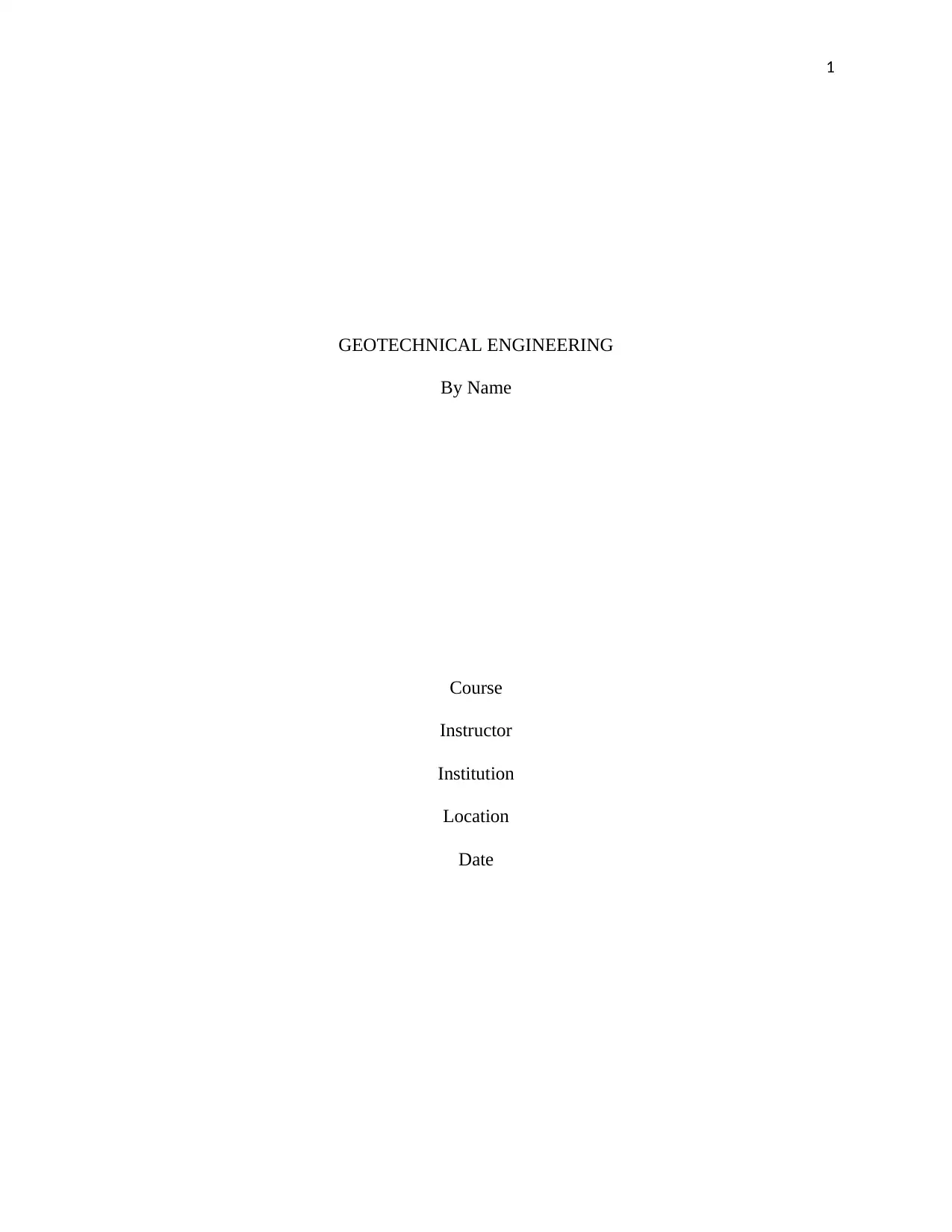
1
GEOTECHNICAL ENGINEERING
By Name
Course
Instructor
Institution
Location
Date
GEOTECHNICAL ENGINEERING
By Name
Course
Instructor
Institution
Location
Date
Paraphrase This Document
Need a fresh take? Get an instant paraphrase of this document with our AI Paraphraser
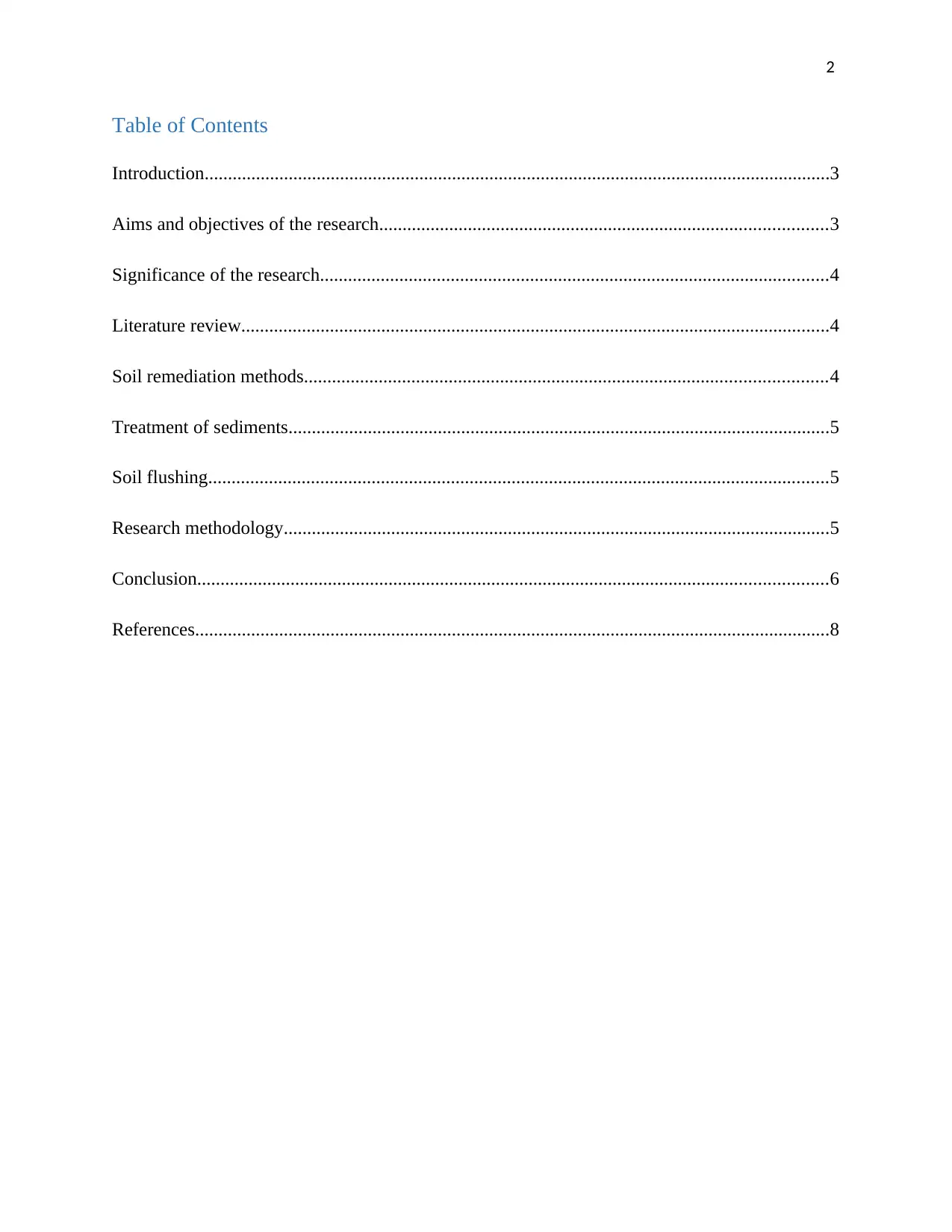
2
Table of Contents
Introduction......................................................................................................................................3
Aims and objectives of the research................................................................................................3
Significance of the research.............................................................................................................4
Literature review..............................................................................................................................4
Soil remediation methods................................................................................................................4
Treatment of sediments....................................................................................................................5
Soil flushing.....................................................................................................................................5
Research methodology.....................................................................................................................5
Conclusion.......................................................................................................................................6
References........................................................................................................................................8
Table of Contents
Introduction......................................................................................................................................3
Aims and objectives of the research................................................................................................3
Significance of the research.............................................................................................................4
Literature review..............................................................................................................................4
Soil remediation methods................................................................................................................4
Treatment of sediments....................................................................................................................5
Soil flushing.....................................................................................................................................5
Research methodology.....................................................................................................................5
Conclusion.......................................................................................................................................6
References........................................................................................................................................8
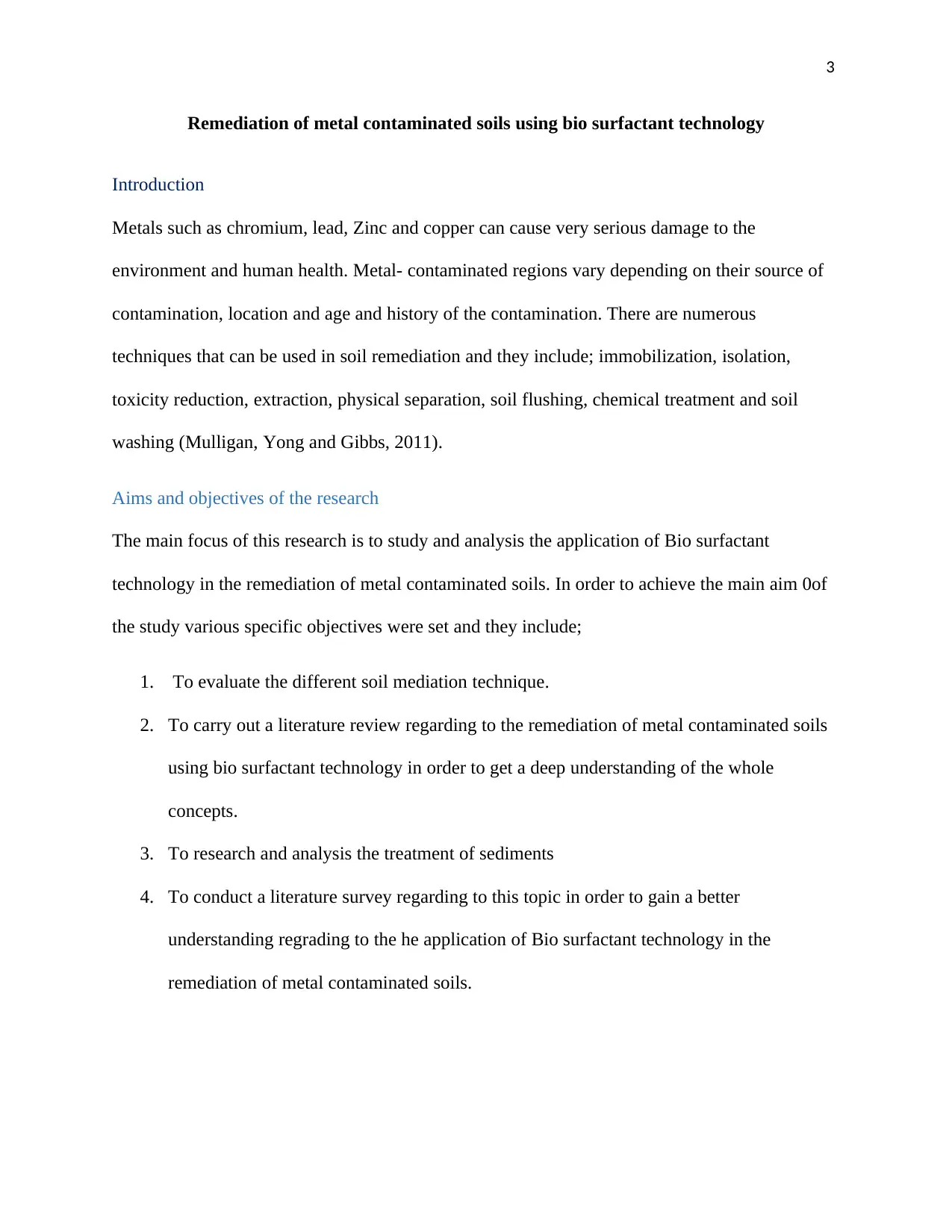
3
Remediation of metal contaminated soils using bio surfactant technology
Introduction
Metals such as chromium, lead, Zinc and copper can cause very serious damage to the
environment and human health. Metal- contaminated regions vary depending on their source of
contamination, location and age and history of the contamination. There are numerous
techniques that can be used in soil remediation and they include; immobilization, isolation,
toxicity reduction, extraction, physical separation, soil flushing, chemical treatment and soil
washing (Mulligan, Yong and Gibbs, 2011).
Aims and objectives of the research
The main focus of this research is to study and analysis the application of Bio surfactant
technology in the remediation of metal contaminated soils. In order to achieve the main aim 0of
the study various specific objectives were set and they include;
1. To evaluate the different soil mediation technique.
2. To carry out a literature review regarding to the remediation of metal contaminated soils
using bio surfactant technology in order to get a deep understanding of the whole
concepts.
3. To research and analysis the treatment of sediments
4. To conduct a literature survey regarding to this topic in order to gain a better
understanding regrading to the he application of Bio surfactant technology in the
remediation of metal contaminated soils.
Remediation of metal contaminated soils using bio surfactant technology
Introduction
Metals such as chromium, lead, Zinc and copper can cause very serious damage to the
environment and human health. Metal- contaminated regions vary depending on their source of
contamination, location and age and history of the contamination. There are numerous
techniques that can be used in soil remediation and they include; immobilization, isolation,
toxicity reduction, extraction, physical separation, soil flushing, chemical treatment and soil
washing (Mulligan, Yong and Gibbs, 2011).
Aims and objectives of the research
The main focus of this research is to study and analysis the application of Bio surfactant
technology in the remediation of metal contaminated soils. In order to achieve the main aim 0of
the study various specific objectives were set and they include;
1. To evaluate the different soil mediation technique.
2. To carry out a literature review regarding to the remediation of metal contaminated soils
using bio surfactant technology in order to get a deep understanding of the whole
concepts.
3. To research and analysis the treatment of sediments
4. To conduct a literature survey regarding to this topic in order to gain a better
understanding regrading to the he application of Bio surfactant technology in the
remediation of metal contaminated soils.
⊘ This is a preview!⊘
Do you want full access?
Subscribe today to unlock all pages.

Trusted by 1+ million students worldwide
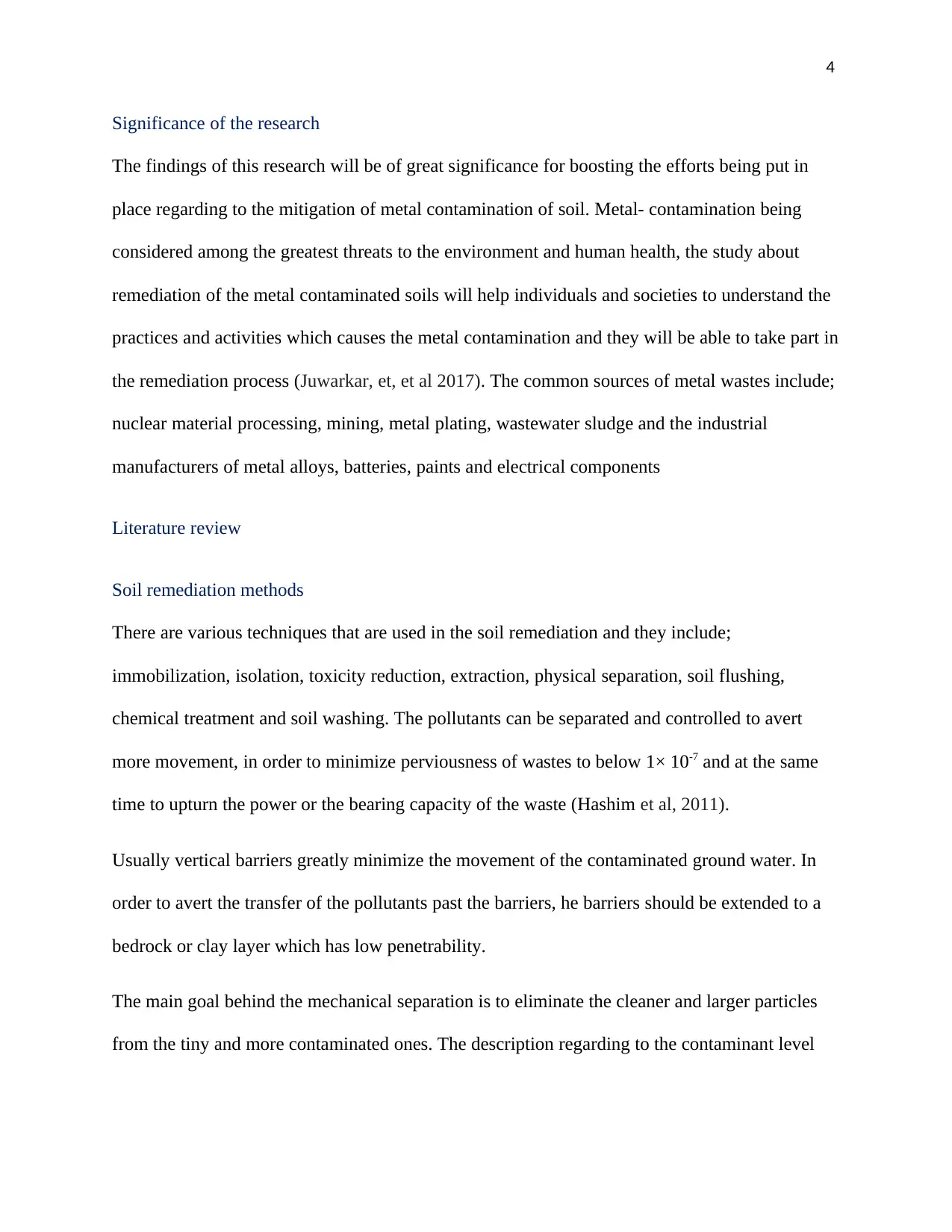
4
Significance of the research
The findings of this research will be of great significance for boosting the efforts being put in
place regarding to the mitigation of metal contamination of soil. Metal- contamination being
considered among the greatest threats to the environment and human health, the study about
remediation of the metal contaminated soils will help individuals and societies to understand the
practices and activities which causes the metal contamination and they will be able to take part in
the remediation process (Juwarkar, et, et al 2017). The common sources of metal wastes include;
nuclear material processing, mining, metal plating, wastewater sludge and the industrial
manufacturers of metal alloys, batteries, paints and electrical components
Literature review
Soil remediation methods
There are various techniques that are used in the soil remediation and they include;
immobilization, isolation, toxicity reduction, extraction, physical separation, soil flushing,
chemical treatment and soil washing. The pollutants can be separated and controlled to avert
more movement, in order to minimize perviousness of wastes to below 1× 10-7 and at the same
time to upturn the power or the bearing capacity of the waste (Hashim et al, 2011).
Usually vertical barriers greatly minimize the movement of the contaminated ground water. In
order to avert the transfer of the pollutants past the barriers, he barriers should be extended to a
bedrock or clay layer which has low penetrability.
The main goal behind the mechanical separation is to eliminate the cleaner and larger particles
from the tiny and more contaminated ones. The description regarding to the contaminant level
Significance of the research
The findings of this research will be of great significance for boosting the efforts being put in
place regarding to the mitigation of metal contamination of soil. Metal- contamination being
considered among the greatest threats to the environment and human health, the study about
remediation of the metal contaminated soils will help individuals and societies to understand the
practices and activities which causes the metal contamination and they will be able to take part in
the remediation process (Juwarkar, et, et al 2017). The common sources of metal wastes include;
nuclear material processing, mining, metal plating, wastewater sludge and the industrial
manufacturers of metal alloys, batteries, paints and electrical components
Literature review
Soil remediation methods
There are various techniques that are used in the soil remediation and they include;
immobilization, isolation, toxicity reduction, extraction, physical separation, soil flushing,
chemical treatment and soil washing. The pollutants can be separated and controlled to avert
more movement, in order to minimize perviousness of wastes to below 1× 10-7 and at the same
time to upturn the power or the bearing capacity of the waste (Hashim et al, 2011).
Usually vertical barriers greatly minimize the movement of the contaminated ground water. In
order to avert the transfer of the pollutants past the barriers, he barriers should be extended to a
bedrock or clay layer which has low penetrability.
The main goal behind the mechanical separation is to eliminate the cleaner and larger particles
from the tiny and more contaminated ones. The description regarding to the contaminant level
Paraphrase This Document
Need a fresh take? Get an instant paraphrase of this document with our AI Paraphraser
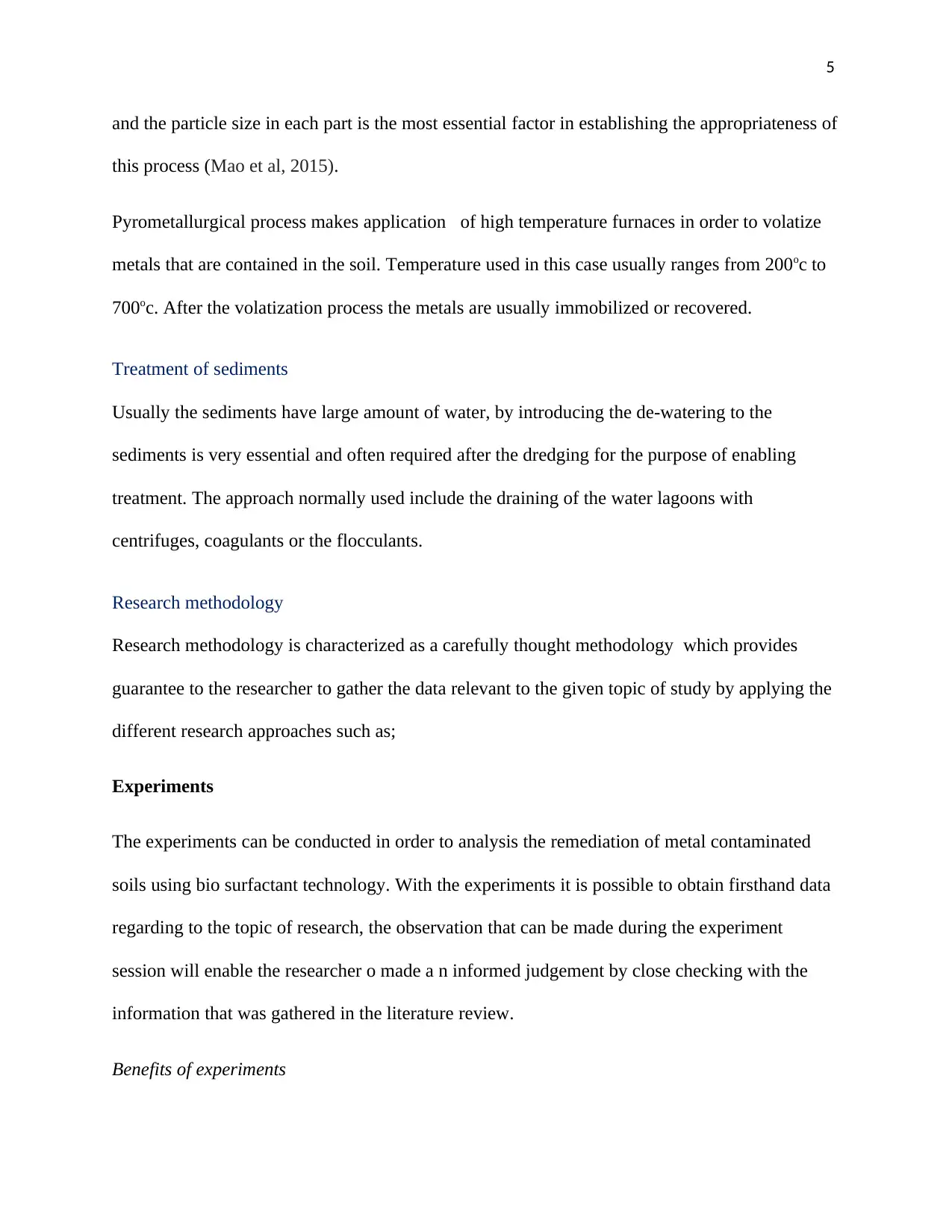
5
and the particle size in each part is the most essential factor in establishing the appropriateness of
this process (Mao et al, 2015).
Pyrometallurgical process makes application of high temperature furnaces in order to volatize
metals that are contained in the soil. Temperature used in this case usually ranges from 200oc to
700oc. After the volatization process the metals are usually immobilized or recovered.
Treatment of sediments
Usually the sediments have large amount of water, by introducing the de-watering to the
sediments is very essential and often required after the dredging for the purpose of enabling
treatment. The approach normally used include the draining of the water lagoons with
centrifuges, coagulants or the flocculants.
Research methodology
Research methodology is characterized as a carefully thought methodology which provides
guarantee to the researcher to gather the data relevant to the given topic of study by applying the
different research approaches such as;
Experiments
The experiments can be conducted in order to analysis the remediation of metal contaminated
soils using bio surfactant technology. With the experiments it is possible to obtain firsthand data
regarding to the topic of research, the observation that can be made during the experiment
session will enable the researcher o made a n informed judgement by close checking with the
information that was gathered in the literature review.
Benefits of experiments
and the particle size in each part is the most essential factor in establishing the appropriateness of
this process (Mao et al, 2015).
Pyrometallurgical process makes application of high temperature furnaces in order to volatize
metals that are contained in the soil. Temperature used in this case usually ranges from 200oc to
700oc. After the volatization process the metals are usually immobilized or recovered.
Treatment of sediments
Usually the sediments have large amount of water, by introducing the de-watering to the
sediments is very essential and often required after the dredging for the purpose of enabling
treatment. The approach normally used include the draining of the water lagoons with
centrifuges, coagulants or the flocculants.
Research methodology
Research methodology is characterized as a carefully thought methodology which provides
guarantee to the researcher to gather the data relevant to the given topic of study by applying the
different research approaches such as;
Experiments
The experiments can be conducted in order to analysis the remediation of metal contaminated
soils using bio surfactant technology. With the experiments it is possible to obtain firsthand data
regarding to the topic of research, the observation that can be made during the experiment
session will enable the researcher o made a n informed judgement by close checking with the
information that was gathered in the literature review.
Benefits of experiments
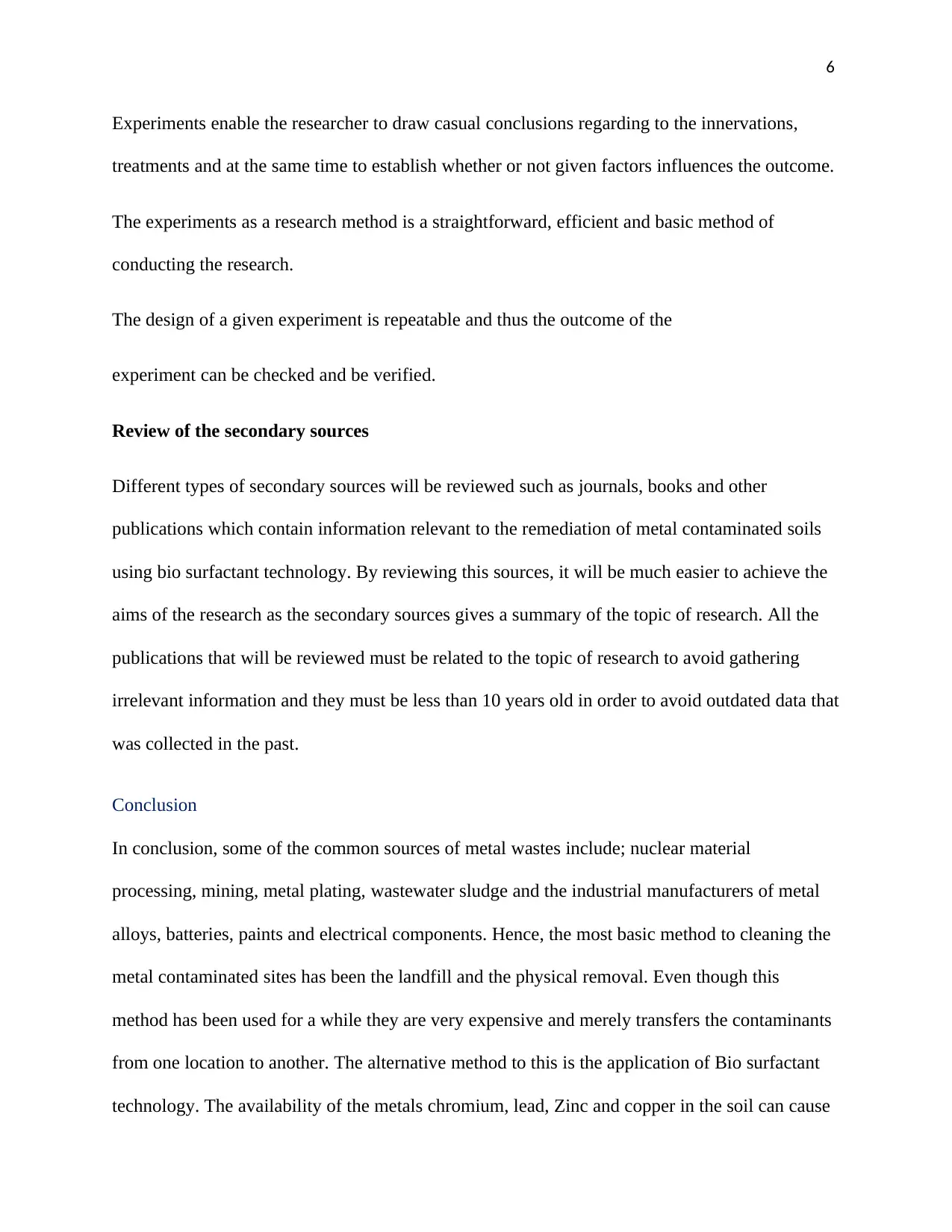
6
Experiments enable the researcher to draw casual conclusions regarding to the innervations,
treatments and at the same time to establish whether or not given factors influences the outcome.
The experiments as a research method is a straightforward, efficient and basic method of
conducting the research.
The design of a given experiment is repeatable and thus the outcome of the
experiment can be checked and be verified.
Review of the secondary sources
Different types of secondary sources will be reviewed such as journals, books and other
publications which contain information relevant to the remediation of metal contaminated soils
using bio surfactant technology. By reviewing this sources, it will be much easier to achieve the
aims of the research as the secondary sources gives a summary of the topic of research. All the
publications that will be reviewed must be related to the topic of research to avoid gathering
irrelevant information and they must be less than 10 years old in order to avoid outdated data that
was collected in the past.
Conclusion
In conclusion, some of the common sources of metal wastes include; nuclear material
processing, mining, metal plating, wastewater sludge and the industrial manufacturers of metal
alloys, batteries, paints and electrical components. Hence, the most basic method to cleaning the
metal contaminated sites has been the landfill and the physical removal. Even though this
method has been used for a while they are very expensive and merely transfers the contaminants
from one location to another. The alternative method to this is the application of Bio surfactant
technology. The availability of the metals chromium, lead, Zinc and copper in the soil can cause
Experiments enable the researcher to draw casual conclusions regarding to the innervations,
treatments and at the same time to establish whether or not given factors influences the outcome.
The experiments as a research method is a straightforward, efficient and basic method of
conducting the research.
The design of a given experiment is repeatable and thus the outcome of the
experiment can be checked and be verified.
Review of the secondary sources
Different types of secondary sources will be reviewed such as journals, books and other
publications which contain information relevant to the remediation of metal contaminated soils
using bio surfactant technology. By reviewing this sources, it will be much easier to achieve the
aims of the research as the secondary sources gives a summary of the topic of research. All the
publications that will be reviewed must be related to the topic of research to avoid gathering
irrelevant information and they must be less than 10 years old in order to avoid outdated data that
was collected in the past.
Conclusion
In conclusion, some of the common sources of metal wastes include; nuclear material
processing, mining, metal plating, wastewater sludge and the industrial manufacturers of metal
alloys, batteries, paints and electrical components. Hence, the most basic method to cleaning the
metal contaminated sites has been the landfill and the physical removal. Even though this
method has been used for a while they are very expensive and merely transfers the contaminants
from one location to another. The alternative method to this is the application of Bio surfactant
technology. The availability of the metals chromium, lead, Zinc and copper in the soil can cause
⊘ This is a preview!⊘
Do you want full access?
Subscribe today to unlock all pages.

Trusted by 1+ million students worldwide

7
very serious damage to the environment and human health. Various methods will be applied to
gather information relevant to the topic of the research such as experimentations and reviewing
of secondary sources which contain information relevant to the topic of the study
very serious damage to the environment and human health. Various methods will be applied to
gather information relevant to the topic of the research such as experimentations and reviewing
of secondary sources which contain information relevant to the topic of the study
Paraphrase This Document
Need a fresh take? Get an instant paraphrase of this document with our AI Paraphraser
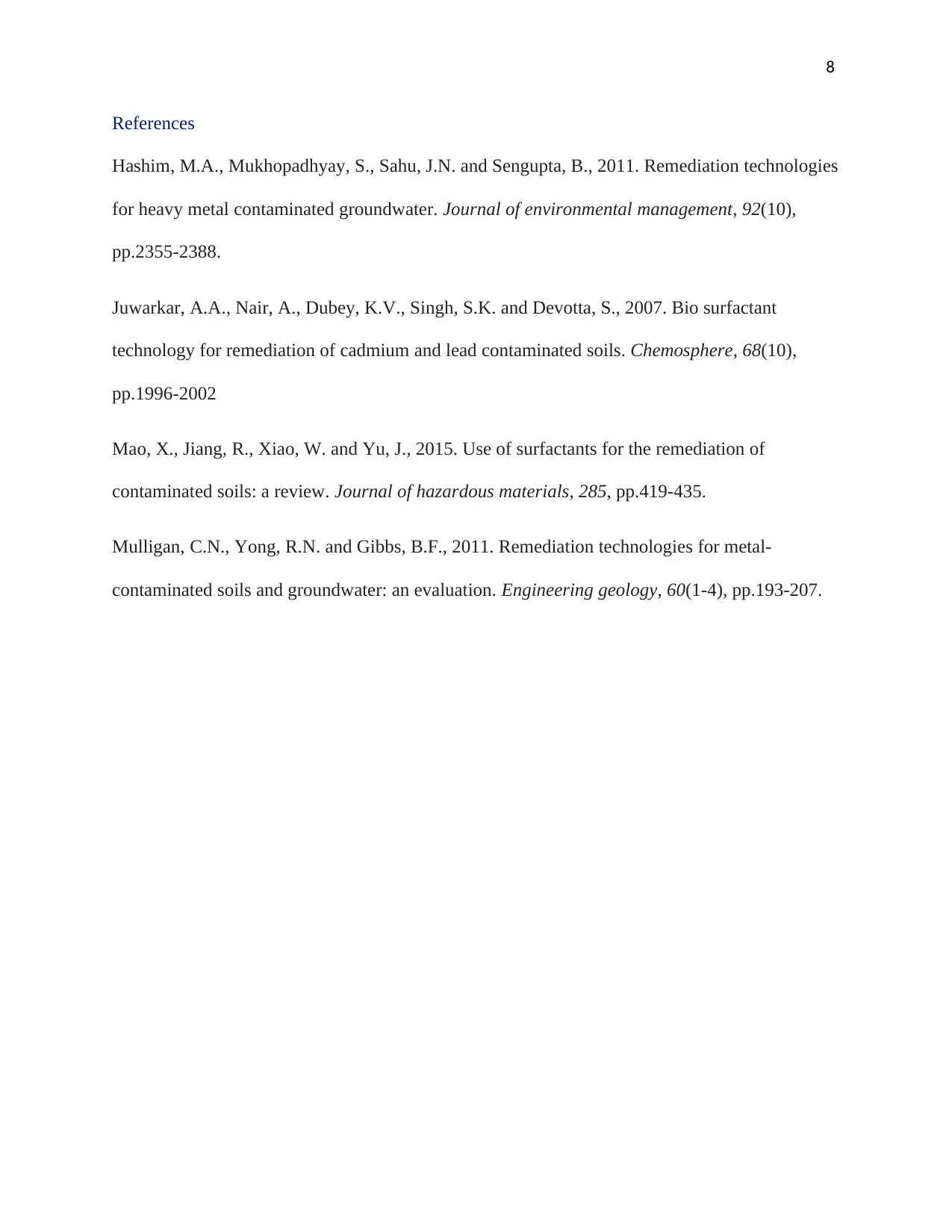
8
References
Hashim, M.A., Mukhopadhyay, S., Sahu, J.N. and Sengupta, B., 2011. Remediation technologies
for heavy metal contaminated groundwater. Journal of environmental management, 92(10),
pp.2355-2388.
Juwarkar, A.A., Nair, A., Dubey, K.V., Singh, S.K. and Devotta, S., 2007. Bio surfactant
technology for remediation of cadmium and lead contaminated soils. Chemosphere, 68(10),
pp.1996-2002
Mao, X., Jiang, R., Xiao, W. and Yu, J., 2015. Use of surfactants for the remediation of
contaminated soils: a review. Journal of hazardous materials, 285, pp.419-435.
Mulligan, C.N., Yong, R.N. and Gibbs, B.F., 2011. Remediation technologies for metal-
contaminated soils and groundwater: an evaluation. Engineering geology, 60(1-4), pp.193-207.
References
Hashim, M.A., Mukhopadhyay, S., Sahu, J.N. and Sengupta, B., 2011. Remediation technologies
for heavy metal contaminated groundwater. Journal of environmental management, 92(10),
pp.2355-2388.
Juwarkar, A.A., Nair, A., Dubey, K.V., Singh, S.K. and Devotta, S., 2007. Bio surfactant
technology for remediation of cadmium and lead contaminated soils. Chemosphere, 68(10),
pp.1996-2002
Mao, X., Jiang, R., Xiao, W. and Yu, J., 2015. Use of surfactants for the remediation of
contaminated soils: a review. Journal of hazardous materials, 285, pp.419-435.
Mulligan, C.N., Yong, R.N. and Gibbs, B.F., 2011. Remediation technologies for metal-
contaminated soils and groundwater: an evaluation. Engineering geology, 60(1-4), pp.193-207.
1 out of 8
Related Documents
Your All-in-One AI-Powered Toolkit for Academic Success.
+13062052269
info@desklib.com
Available 24*7 on WhatsApp / Email
![[object Object]](/_next/static/media/star-bottom.7253800d.svg)
Unlock your academic potential
Copyright © 2020–2025 A2Z Services. All Rights Reserved. Developed and managed by ZUCOL.




